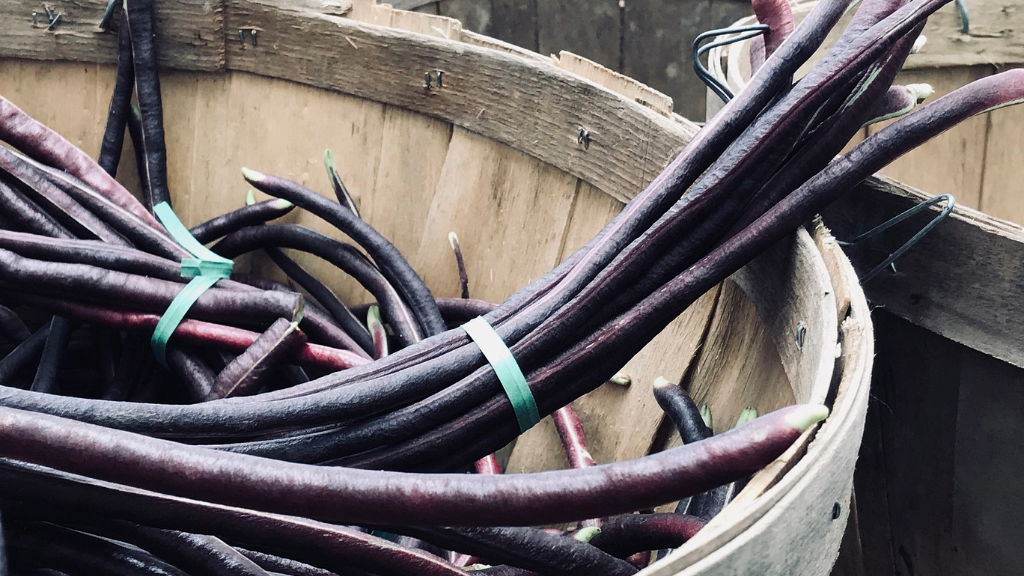History Of Purple Podded Yard Long Beans


There's a good reason why purple podded yard beans are often known as snake beans. This heirloom vegetable plant produces beans that can reach surprising lengths of 30 inches. And if extreme length isn't enough of an attention grabber, the attractive, drooping pods contain natural phytochemicals that give them a deep purple color. The delicate-looking blooms provide their share of color too; they are pale purple with a dark purple center and two bright yellow dots. An amazing plant with lots to offer - grow them to eat, grow them simply as ornamentals or grow them for wildlife.
History of Purple Podded Yard Long Beans
Yard long beans (Vigna sesquipedalis) may resemble pole snap beans (Phaseolus vulgaris) but they are actually closely related to southern cowpeas (Vigna unguiculata), botanically speaking anyway. They originate from Southeast Asia. The history of these particular heirloom yard long beans is sketchy, however, but experts are fairly certain this plant originated many years ago in Thailand, where it is still very popular. In fact, some people know this plant as Thai purple-podded bean or Thai yard long asparagus bean plants - tongue twister, say that three times.
Growing Yard Long Asparagus Beans
If you want to grow your own yard long beans, it isn't difficult so long as you can provide a long, hot growing season and at least of six hours of dependable sunlight per day. The plants tolerate nearly any type of well-drained soil, but they are happier if you work in a few inches of compost or rotten manure, along with an all-purpose fertilizer. Don't rush to get the beans in the ground. Wait until late spring when daytime temperatures are above 60 F. (15 C.). Then you can plant your beans 12 inches apart in rows, with 3 to 4 feet between each row. If you prefer, you can plant the beans in hills. Don't crowd them; these vigorous plants require quite a bit of space. Remember, they're lengthy. Cover the beans with 1 to 1 ½ inches of soil, then keep them evenly moist, but not soggy, until the beans germinate - usually seven to 10 days if the weather is warm. Thereafter, provide about an inch of water every week. Be as consistent as possible and avoid extremes of moisture, which can cause dropped blossoms or malformed pods. A couple inches of bark mulch or dry grass clippings can moderate soil moisture and temperature. You might want to install a support for the plant once they are still fairly small so you can begin training the twirling, twining stems to wind around the support. A fence or trellis works just fine, but many gardeners, such as myself, use a tripod consisting of three or four 6- to 7-foot poles arranged teepee-fashion. Unfinished wood is great because the rough surface gives the vines something to grab. Don't make the support too tall; remember that you will need to reach the vines at the top when the beans are ready to harvest. And when that time comes, those super-long pods will be quite impressive, but if you're going for flavor, the beans are most tender, sweet and mild at only 10 to 12 inches.
Gardening tips, videos, info and more delivered right to your inbox!
Sign up for the Gardening Know How newsletter today and receive a free copy of our e-book "How to Grow Delicious Tomatoes".

A Credentialed Garden Writer, Mary H. Dyer was with Gardening Know How in the very beginning, publishing articles as early as 2007.
-
 Create A Romantic Garden Straight Out Of Bridgerton: Regency Era Romance In Your Garden
Create A Romantic Garden Straight Out Of Bridgerton: Regency Era Romance In Your GardenTry some romantic garden ideas straight out of Bridgerton. Flowers and gardens in the Regency era were lush and charming and you can get the same look!
By Bonnie L. Grant
-
 Moody Blooms For Spring: 8 Types Of Black Flowers To Add Drama To Spring Displays
Moody Blooms For Spring: 8 Types Of Black Flowers To Add Drama To Spring DisplaysFrom midnight burgundies to inky violets, several types of black flowers can enrich and embolden a spring display. Try these brooding bloomers for a moody garden
By Tonya Barnett